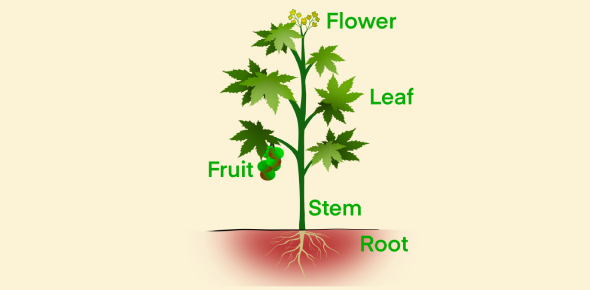A group of similar cells organized into a structural and functional...
The meristem at the tip of the root or shoot in a vascular plant.
A minute opening bordered by guard cells in the epidermis of leaves...
Ground tissue in the center of the stem.
The region of the stem between two successive nodes.
A scar left on a twig when a leaf falls, formed by the protective...
Growth that occurs within the lateral meristems.
Portion of the ground tissue between the epidermis and the vascular...
A fruit is a mature _________.
The lateral meristem that forms the periderm, producing cork toward...
Name a principle function of the stem.
An undivided leaf as opposed to a compound leaf.
Pairs of specialized epidermal cells surrounding a pore, or stoma.
A simple term for secondary xylem is
The palisade and spongy parenchyma.
In most vascular plants, what is the principle organ of...
The outermost primary permanent tissue in the root.
The primary root of a plant formed in direct continuation with the...
A specialized parenchyma cell associated with a sieve-tube element in...
In plants, growth derived from secondary or lateral meristems, the...
The meristem that produces the periderm/cork
Responsible for all primary or lateral growth in the tips of the roots...
The last part of the growth increment formed in the growing season; it...
The part of a stem where one or more leaves are attached.
The first-formed wood of a growth increment, it contains larger cells...
A root that arises from another, older root; also called a branch...
Outer protective tissue that replaces epidermis when it is destroyed...
Primary meristematic tissue that gives rise to epidermal tissue.
The protective tissues formed outside by the cork cambium.
A secondary tissue produced by a cork cambium; made up of polygonal...
Main axis of a spike; the axis of a fern leaf, from which the pinnae...
The primary meristem that gives rise to the ground tissue.
The first root of the plant, developing in continuation of the root...
Tubular outgrowths of epidermal cells of the root; greatly increase...
The tissue from which lateral or branch roots originate
Name one of the three primary meristems which are precursors of the...
Class of angiosperms which is the smaller class that contains 90,000...
An elongated, thick-walled conducting and supporting cell of xylem. It...
Upper angle between the leaf and the stem.
Nonliving and commonly dark-colored wood in which no water transport...
Embryonic tissue regions, primarily concerned with formation of new...
The part of the wall of sieve-tube elements bearing one or more highly...
A tissue characteristic of roots that is bounded externally by the...
A name commonly applied to the wood of a conifer.
The stem and leaf are collectively referred to as the
Primary meristematic tissue that gives rise to vascular tissue.
In wood, the growth layer formed during a single year.
The pattern of venation in which the principal veins of the leaf are...
A name commonly applied to the wood of a magnolid or eudicot tree.
A sclerenchyma cell with a thick, lignified secondary wall having many...
An elongated, tapering, generally thick walled sclerenchyma cell of...
Root hiars form in which growth region of the root?
A tissue composed of a single cell type; parenchyma, collenchyma, and...
How many pounds of pressure do the xylem cells exert?
Name one of the two root systems associated with monocots or eudicots...
What is the name given to the ovary wall? This structure thickens and...
A tissue formed inwardly by the cork cambium, opposite the cork; inner...
A growth layer in the secondary xylem or secondary phloem, as seen in...
Consists of a hollow cylinder one cell thick and makes up 90% of the...
Vascular bundles that contain the two vascular tissues, xylem and...
A tissue or group of tissues organized into a structural or functional...
A series of sieve-tube elements arranged end to end and interconnected...
Produces secondary xylem to the inside of the vascular cylinder.
A leaf tissue composed of loosely arranged, chloroplast-bearing cells.
A structure at the base of the embryo in many vascular plants. In some...
A long, slender sieve element with relatively unspecialized sieve...
Class of angiosperms which is the largest with at least 200,000...
The stalk of the ovule.
Elongated living cell with unevenly thickened, nonlignified primary...
The phylum that includes the angiosperms
The arrangement of veins in the leaf blade that resembles a net;...
A tissue derived from the apical meristem; of three kinds protoderm,...
A thimblelike mass of cells that covers and protects the growing tip...
What is the name of the modified stem from which all flower parts...
The part of the vascular bundle extending from the base of the leaf to...
Cell of variable form and size with more or less thick, often...
A wood in which the pores, or vessels, are fairly uniformly...
The part of the plant body arising from the apical meristems and their...
Tissue region between vascular bundles in a stem.
The wide gap, or region of ground tissue, found in the vascular...
The general term for a water-conducting cell in vascular plants;...
A wood in which the pores, or vessels, of the early wood are...
The two lateral meristems are the ____ cambium and the _____ cambium....
A leaf tissue composed of columnar chloroplast-bearing cells.
A portion of the sieve element wall containing clusters of pores...
One of the component cells of a sieve-tube; found primarily in...
A leaf whose blade is divided into several distinct leaflets.
A developmental process by which relatively unspecialized cell...
















